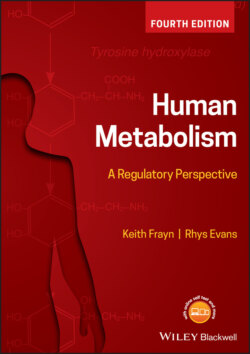Читать книгу Human Metabolism - Keith N. Frayn - Страница 46
1.3.4 Protein metabolism 1.3.4.1 Pathways of amino acid metabolism
ОглавлениеAmino acids may be synthesised, obtained from the diet or derived from proteolysis (although no dedicated protein exists whose sole function is simply to supply amino acids for energy). ‘Non- essential’ amino acids can be synthesised from intermediary metabolites (or from other amino acids); ‘essential’ amino acids cannot be synthesised by humans and therefore must be obtained from the diet. ‘Conditionally essential’ amino acids can be synthesised in only limited amounts, and this must be supplemented by the diet in states of rapid protein synthesis (e.g. growth). Free amino acids constitute a soluble amino acid substrate pool; this is quantitatively small, but dynamic, turning over rapidly. From this pool, amino acids are used for biosynthetic functions as well as degradation for energy production, their carbon skeletons entering the common metabolic pool of intermediary metabolites shared with carbohydrate and lipid metabolism. Dietary amino acids surplus to synthetic requirements (for proteins, nucleotides, hormones, neurotransmitters, creatine, porphyrins etc.) are utilised directly for energy production. Some tissues (e.g. liver, intestine, leukocytes) preferentially oxidise amino acids for energy. Amino acids contain approximately the same energy as carbohydrates – about half that of lipids. Amino acids may be used to provide metabolic energy either (i) in the well-fed state, when amino acid intake exceeds protein synthesis requirement, in which case excess exogenous amino acids are oxidised or stored as non-protein energy reserve, or (ii) in starvation, when endogenous amino acids derived from ‘dispensable’ protein are oxidised for energy.
Whilst amino acids are used to synthesise proteins, most proteins are not inert but are constantly broken down (proteolysis) to amino acids and re-synthesised (protein synthesis), this constituting the protein turnover rate: this cycling varies between individual proteins. For a protein to be useful as a source of amino acids for energy production, its turnover rate must be relatively high, and there must be a relatively large amount of it in the body (and it must be, at least in part, expendable). The rate of protein turnover depends on the individual protein – generally, gastrointestinal and hepatic proteins turn over rapidly (5–15% per day) whilst skeletal muscle contractile protein turnover is relatively slow (∼2% per day) (see Chapter 7 for more detail); however, because of the large mass of skeletal muscle, and the ability to maintain viability despite loss of >50% of actin and myosin, this depot makes the largest contribution to whole body protein turnover, and hence amino acid availability for metabolism and energy release.
Typical dietary protein intake is ∼100 g d−1 (with the same amount excreted as nitrogen- equivalent), whilst the ∼10 kg of body protein is turned over to ∼100 g of free amino acids at a turnover rate of ∼300 g d−1. Dietary proteins are digested in the small intestine and absorbed as free amino acids and short peptides (see Chapter 4, Section 4.3.2). Enterocytes of the small intestine remove some amino acids, especially glutamine, for use as an oxidative fuel (see Chapter 5.8). The remaining products of digestion enter the portal vein and then the liver, where further preferential amino acid extraction occurs (most are extracted by the liver). Amino acid oxidation is, under most circumstances, the major oxidative pathway in the liver – about 60% of incoming amino acids may be directed into immediate oxidation. The rate of hepatic protein synthesis is also high, and since much of the protein is secreted (e.g. albumin), this represents a net loss of amino acids from the liver (perhaps a further 20% of the incoming amino acids). The remaining mixture of amino acids, around 20% of those absorbed, enters the systemic circulation. This mixture is enriched in branched chain amino acids (leucine, isoleucine, and valine), which have a special role in muscle (see Chapter 5.3.3.3). Branched chain amino acids make up approximately one third of all amino acids in the body; whilst the other amino acids are metabolised principally in the liver, these essential amino acids are metabolised in peripheral (non-hepatic) tissue, especially skeletal muscle.
Although multiple amino acids exist in vivo, and individual amino acid metabolic pathways exist, most follow a common biochemical strategy to yield their energy. Amino acids contain C, H, O atoms, like carbohydrates and lipids, but also a distinguishing N atom in the amino group (see Section 1.2.2.3 and Figure 1.11). Therefore the essential feature of amino acid metabolism is removal of the amino-N group (deamination). Deamination of amino acids produces ammonia (NH3) and the ‘carbon skeleton.’ Ammonia is highly toxic and must either be excreted directly into the urine (kidney) or converted into relatively non-toxic urea in the urea (ornithine) cycle (liver) (or, occasionally, incorporated into some other biomolecules), followed by utilisation of the remaining carbon skeleton (2-oxoacid; α-ketoacid) (Figure 1.19). The fate of the 2-oxoacid carbon skeleton depends on where it enters the common metabolic pool of intermediary metabolism.
Figure 1.19 Metabolism of amino acids. To be metabolised, amino acids must first be deaminated to remove the nitrogen (amino group) from the central α carbon. This leaves the carbon skeleton (the corresponding 2-oxoacid [α-ketoacid]) which undergoes metabolism in the common metabolic pool, by a route which depends on its structure, ultimately producing energy. The amino group becomes ammonia, some of which can be excreted directly in the urine, but most of which must be detoxified by the urea cycle.
